Precursors of the Migration Period1
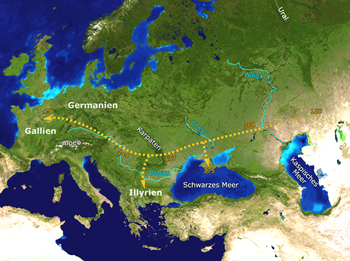
Suggested path of Hunnic movement westwards
Historical research suggests that the ‘Great Migration’ did not actually begin until the 4th Century AD with the invasion of the Huns. However, precursors have been found in the 4th century BC that involved the Celtic2 and Germanic tribes that were called ‘Barbarians’3 by the Romans.
Natural disasters in Scandinavia and North and Baltic Seas were probably some of the reasons for the migration. The increased knowledge of a world to the south, with its favorable living conditions, wealth and order must have appeared to be a paradise for these peoples.
The Bastarnae
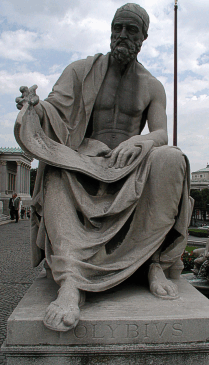
Polybios
The Bastarnae, an East Germanic tribe, were the first known as a Germanic people. The Greek historian Polybius reported about battles of the Bastarnae and Scirii with the Romans in the 3rd century BC.
The Bastarnae originally lived on the upper Vistula and by 230 BC they appeared together with a large part of the East Germanic Scirii, between the Dnieper and Dniester Rivers, where together they besieged the city of Olbia on the shores of the Black Sea.
Around 200 BC, they were located at the northern mouth of the Danube River. 180 BC they appeared on the lower Danube and a little later they fought as mercenaries of the Macedonian King Perseus against Rome.
By 280 AD they were expelled by the Goths and settled by Emperor Probus on Roman territory in Thrace. Evidence of the Bastarnae has been found north of the Danube dating to 391 AD however; traces of them have been lost by the 6th Century AD.
The Scirii

The Scirii originally lived east of the Vistula River in Masuria in today’s Poland. Around 230 BC, the majority of them went south, with the Bastarnae, into the Black Sea region, and they finally settled east of the Bastarnae on the Black Sea.
In the 4th Century AD they were mentioned in conjunction with the East Germanic tribes, the Heruli and Rugii, on the northern edge of the Carpathian Mountains, before they advanced to the Danube.
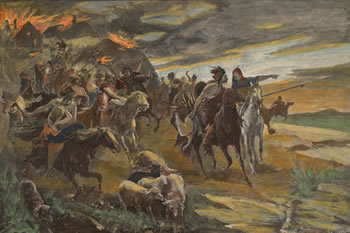
Huns Robbing and Murdering as They Invaded Countries
During the migration period of the 5th Century, they were subjugated by the Huns.
After the death of Attila the Hun in 453, the Scirii Prince Edekon established a short-lived Scirii Empire in the Great Hungarian Plain, but by 469 it had already declined.
Now, some of the Scirii, together with the Visigoths and Ostrogoths moved westward, and became confederates in service to the Romans. By 500, however, traces of the Scirii were lost in today’s Italy.
The Cimbri

Jutland
The Germanic Cimbri had heard from traveling merchants that living in the warm South was better. In 120 BC, together with the Teutons and Ambrones, they moved from their settlement in the North of Central Europe (Jutland) to the South, crossing Bohemia, Silesia, Moravia, into the Danube-Sava-territory and then westward to Gaul. Here the Teutons and the Ambrones separated from the Cimbri. The former moved from the West, the latter from the North into today's Italy. This separation would decide the fate of the tribes.
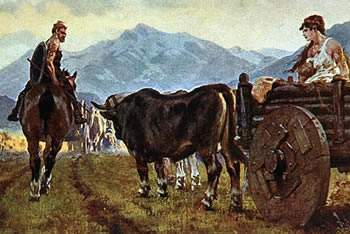
After 100,000 people had traveled 7,000 kilometers in 20 years, through rain, snow and the heat of the South, Roman troops defeated the Teutons at Aquae Sextiae (now Aix-en-Provence) in 102 BC, and the Cimbri in the Po Valley in Vercelli in northern Italy in 101 BC.
What happened in that defeat would be characteristic of the later Germanic tribes: they did not want to be subjected in shame and disgrace as subjugated by Rome and end up as slaves. Freedom or death were their options. They chose death and committed suicide. With this gesture the Cimbri tribe was extinguished.
The Goths
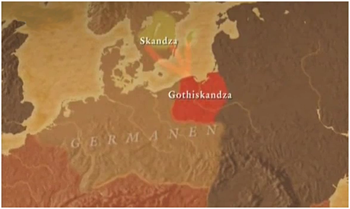
The odyssey of the Goths from Scandinavia (Scandza) began around the birth of Christ. To escape the "eternally dark and inhospitable north," they moved across the Baltic Sea to colonize the coast of present-day Poland and the Vistula River. Then they moved up the Vistula in stages, in search of new and better settlement sites. During their advance they subjugated all their neighbors.
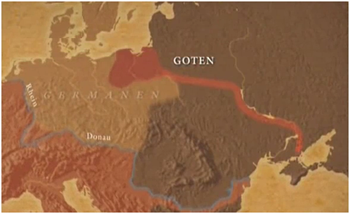
In the 2nd century AD, they then moved, from the Vistula territory, up to the northern coast of the Black Sea and around 230 AD they probably settled on the lower Dnieper River.
From their second home, the Goths migrated again with their families in search of new land to settle. In 257 AD, some of them arrived in Crimea (Crimean Goths), where they became the allies of the settlers from the Roman Empire. The 60,000 Crimean Goths were the first of the migrating Germanic peoples, for centuries, who found a permanent home.
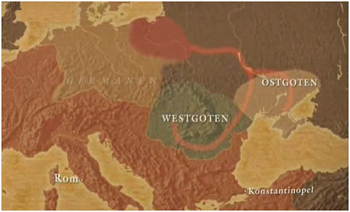
While the Crimean Goths had found their home, other Goth tribes were still wandering, but only legends have survived about their travels. After emigrating from Poland, in 280 AD, the trek divided. The Ostrogoths settled on the northern coast of the Black Sea and the Visigoths moved to Transylvania and to the Danube River, the direct border with the Roman Empire. For the next three generations, today's Romania would be their permanent home.
Of significance were the advances of the Marcomanni4, the Gepids5, and the Vandals6 in the 2nd Century AD, and of the Alemanni and the Franks in the 3rd Century which led to the fall of the Roman Limes (Roman-Germanic frontier) about 260 AD.
The Huns
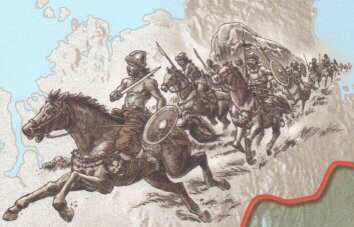
Huns Attack
The Huns7, a wild nomadic horse people, lived on the Highlands in middle Asia.
An army of Mongolian Huns suddenly appeared, in 375 AD, on the Don River in southern Russia, and invaded Europe when they crossed the river. For the people of ancient times, they were the "most terrible of all warriors." They appeared where they are least expected, and fell upon the people with robbery and cunning.
None of them touched a plow or cultivated the land. The only occupation they knew was hunting. They roamed the land and took what they needed: grain, cattle, gold and people.
The Huns had already invaded and subjected many nations: (Gepids5, Scirii, Alans, Ostrogoths, etc). They then invaded the land of the Germanic tribe known as the Teutons.
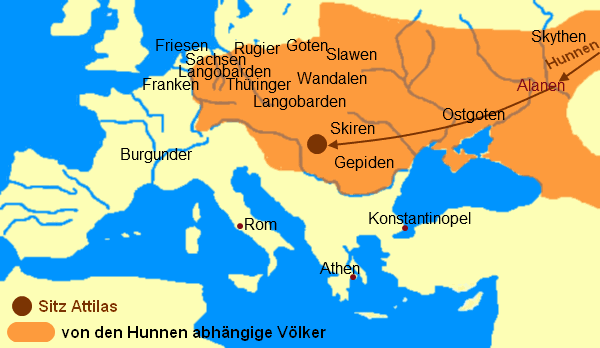
The Hun Empire
Stories have been told about the terrible weapons of the Huns and their incredible range. People have told about their terrible appearance. The only way the Germanic tribes (Visigoths, Vandals6, Burgundians and Suevi) survived was by their escape across the Danube, where they were accepted into the Roman Empire. The Great Migration had begun.
The Migration Period
The migration was not a uniform process, but the sum of population movements and causes at different times and causes (including social change, economic deterioration, the attraction of Roman culture and living conditions.)

Movements from the second to the fifth century
This chaotic time has a certain resemblance to the period after the Second World War. Suddenly everything was on the road: Francs moved to France, Anglo-Saxons to Britain, Goths to Spain and Italy. Europe and the Christian West were formed from their empires.
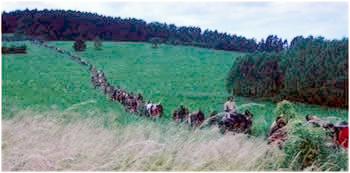
In the following decades, tribes merged and moved together. Endless columns of the people of Germanic tribes clogged the Roman roads.
The Visigoths invaded the Eastern Roman Empire, under Alaric (395-410) they moved to Italy, where they conquered Rome in 410. Later, they moved to southern France (Visigoth Kingdom) and Spain, where they gave their name to the province of Got-Alania = Catalonia. The south of Spain was distributed to the landless (landlos, in German), which when Arabized would mean al(l) Andalus or Andalusia.
The Ostrogoths came to Hungary only after the death of Attila, king of the Huns, in 453 and to Italy in 488.
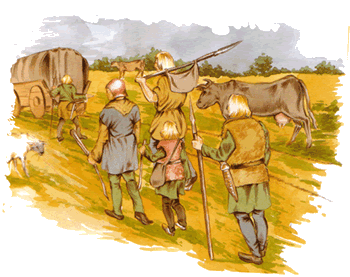
In 409 the Alans-Vandals-Suebi tribal group moved together to Northwest Spain (Galicia), where they formed an independent kingdom under King Hermeric, the kingdom of the Suebi. In 585 the Suebi Kingdom merged in the Spanish Visigothic Kingdom.
Unlike the Suebi, who maintained their domination of North-West Spain and Portugal against the Visigoths up to 585, the Vandals6 and Alans (Caucasian nomads) migrated in 429 to North Africa, the ‘granary’ of the Roman Empire until 439, and made Carthage the capital of the rapidly emerging Vandal Kingdom.
All this, however, was relatively short-lived: the kingdoms of the Ostrogoths and Vandals were destroyed by East Rome and the Visigoths were invaded by the Arabs. Then the Langobards8, a secondary branch of the Suebi, invaded Italy, and remained in the region of Lombardy.
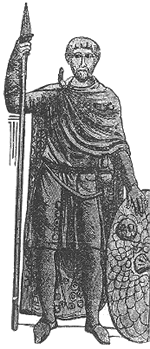
Flavius Aetius
After 406/407 the Bergundians, who had settled between Mainz and Worms, were defeated in 436 by the Roman General Flavius Aetius and the Hun troops resettled in the Rhône area.
From the early 5th Century a part of the tribes of Saxons, Angles and Jutes reached Britain, where they founded their own kingdoms. The permanent immigration of the Franks in Gaul from 350 facilitated the creation and spread of the Kingdom of the Franks under Clovis I in the 5th/6th century.
The migrations ended in Europe from the 8th to the 10th centuries due to the Viking raids.
In East Central Europe a Slavonic westward migration was triggered by the Germanic migrations to the west, which led to the expansion of the Slavic settlement areas to the Elbe River. The German Ostsiedlung had begun.
![]()
1 Thanks to S. Winkler for help with the English translation of this page
2 Celts = The core area of early Celtic settlement is in southwestern Central Europe, where they have been detectable at least since 7/6 Century BC. From the year 300 BC, as a result of increasing population density in the original Celtic areas, an increased migration movement occurred of whole detachments of Celtic tribes. Their targets were new settlement areas that they had conquered, only partially, in war. They temporarily occupied Central and Southern Europe from the Iberian Peninsula (Celtiberians), France (Gauls), the British Isles (Wales, Scotland, Ireland), the Northern Alps and foothills, part of the Italian Boot (Etruscans), and down the Danube (Thracians) to the present-day Turkey (Galatians, the same people spoken about in the ninth book of the New Testament). Cities such as Paris, Turin, Budapest and Ankara were established by them.
3 Barbarians = originally, among the Greeks, it included anyone who didn’t speak Greek. Since the Persian wars it was connected with the significance of uneducated, rude and cruel people.
The Romans used it to refer to all people living outside of the area commonly referred to as the sphere of Greek-Roman culture. Today, it is a slang term for a raw and uneducated people.
4 Marcomanni (in German: Markomannen, the plural of Markomann; it is a composed substantive of Mark (antique word for border area) and Mann (man); the 'o' between the two words can be considered like a glue for a easier pronunciation; so the significant is: men who lives in the border area) were a large Germanic group of the Suevi tribe, probably expelled from the Elbe at the beginning of the 1st century BC. They then settled on the Main River, in the current Franconia and displaced the indigenous Celts.
During Caesar's time, they were in the north-eastern half of the Kingdom of Bavaria. They had been defeated by the Romans in 9 BC and together with the Quadi under King Maroboduus they moved to Bohemia, to the land of the Boii (Celtic tribe) which penetrated from Gaul around 400 BC to an area in Nothern Italy (capital Bononia, today Bologna) or in Bohemia (Boiohaemum named after him), situated in the north of the Danube, where Maroboduus, in alliance with other Germanic tribes established a great Germanic Empire, which was perceived by the Roman Emperor Augustus as a potential threat to Rome. In 19 AD, the Marcomanni, came under Roman influence and were a Roman client state for 30 years. The pressure of other Germanic tribes, social and economic changes, and the weakness of the defense of the Roman Empire led to the Marcomannic wars, which lasted, with interruptions from 166 to 180 AD.
In 433 the Marcomanni, living in Pannonia, came under the rule of the Huns. In the 6th century, they immigrated to Bavaria and their name is gradually lost. From then on, it appeared under the name of Bavaria, a name that they had already brought from their Bohemian homeland, where they were called 'Vaiwarier', i.e. residents of Baiheim in Bohemia.
5 Gepids = Eastgermanic tribes, were mentioned for the first time in the middle of the third Century AD. They settled at that time in the Vistula Delta. It appears that along with the Goths, the Gepids settled around 250 in the Carpathian region of the lower Danube (Transylvania), where they remained until the beginning of the 5th Century as allies or as subjects of the Goths. At the end of the 4th Century the Gepids like the Ostrogoths, were dominated by the Huns. After Attila’s death (453) the Gepid King, Ardaric, freed Southeastern Europe from domination by the Huns.
6 Vandals = East Germanic people, whose original settlement area is unknown, the most significant tribes were the Hasdingi and Silings (Silesia is named after the latter) and who settled in the Oder-Warta region.
During the Marcomannic wars (166-180) hordes of Vandals, settled on the eastern slopes of the Carpathians and later into the fluvial basin of the Tisza. In 406-407 the Vandals crossed the Rhine River with Suevi and Alans (Caucasian nomads tribes) and in 409 they arrived in Spain, where in 411 they received land grants as Roman federates: the Hasdingi and Suevi in the area known as Galicia today, and the Silings in the area now known as Andalusia. There they were besieged by the Visigoths. About 80,000 Vandals and Alans were driven out of Gaiseric to North Africa in 429, where they founded their own kingdom on Roman soil. In 439 the Vandals took Carthage which they made their capital and in 455 the Vandals, appeared with a fleet from Rome, and plundered the city for 14 days. Their Kingdom was destroyed in 533-534 by the Byzantine Commander Flavius Belisarius.
7 Huns = A savage Asian nomadic horse people from the highland of middle Asia, were defeated in the 1st century BC by the Chinese and therefore moved westward. Around 370 AD, under the leadership of Balamir, they subjected the Alans, a Caucasian nomadic tribe who lived on the Terek, Kuban and the lower Don Rivers; and in 375, together with the Alans, they crossed the Don where they conquered the Ostrogoths and then pushed the Visigoths over the Danube. The period from 433 to 454, under the reign of Attila, was the greatest period of Hun power. During this time, they had a huge kingdom north of the Black and Caspian Seas, and the Caucasus through Hungary in the West almost to the Rhine River. They then subordinated the Eastern Roman Empire (441-443, 447) with their incursions. The Huns continued to spread fear with their raids into southern France and Rome before they were defeated by the Romans under Flavius Aetius and the Visigoths in 451 in the Battle of the Catalaunian Plains. In 452 the Huns invaded Italy and devastated many cities, before they retreated from Rome to their ancestral homeland of Pannonia. After the death of Attila (454), his sons Ellac, Dintzic or Dengizich and Erac engaged in a succession of battles with the oppression of more people under the Hun Empire. When Dintzic, Attila's son was killed in battle against the Goths in 468, the name of the Hun Empire disappeared. The surviving Huns were assimilated into other nations.
8 Langobards ("men with long beards" also called Winniler) = Elbe Germanic tribe (part of the Suebi), who settled at the time of the birth of Christ onto the lower Elbe. After hiking and military campaigns ( today's northern and eastern Germany) they occupied areas north of Noricum by 490. Langobards were first mentioned in 488 in the Land of Rugii (Lower Austria). In 508/509 they defeated the Heruli and took over their kingdom on the Morava in today's south of Slovakia. In the 6th Century they extended their settlements to Pannonia to the Sava, destroyed the kingdom of the Gepids in 567 in today's Transylvania and in 568, under King Alboin, they broke into the then Byzantine Italy. The Langobards kingdom with its capital at Pavia encompassed northern Italy and parts of central and southern Italy. Charlemagne, king of the Frankish Empire, conquered Pavia in 774 and crowned himself king of the Langobards. In 951 the territory of the Langobards was connected by Otto I, King of East Frank Empire (Ostfrankenreich), with the Holy Roman Empire of the German Nation. The Duchies of Benevento, Capua and Salerno in the south initially remained independent, until the 11th Century when they came under Norman rule.
